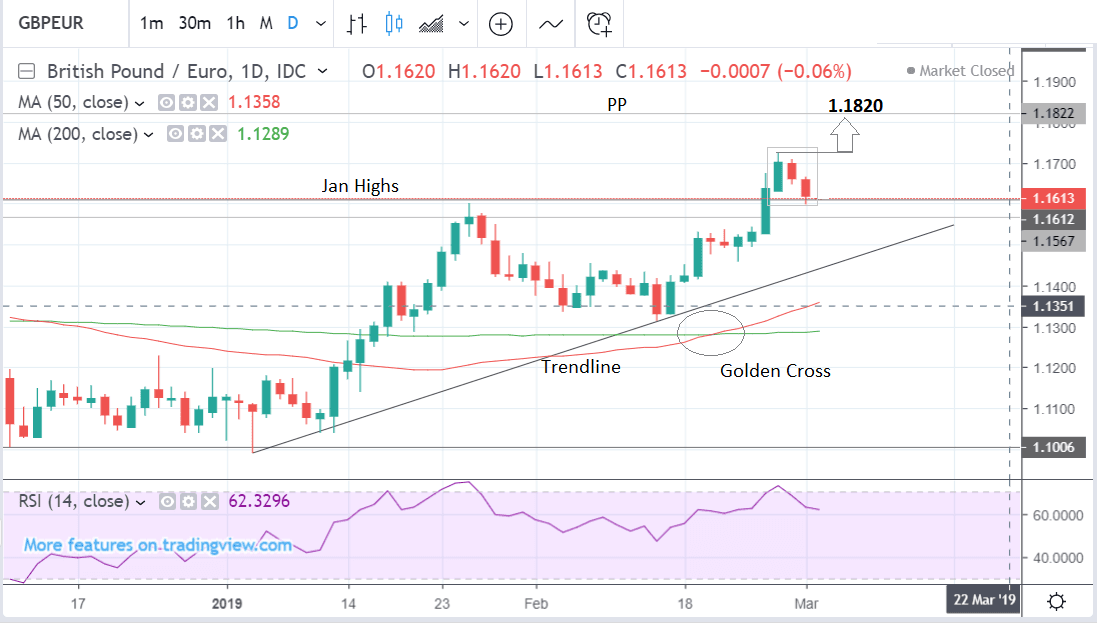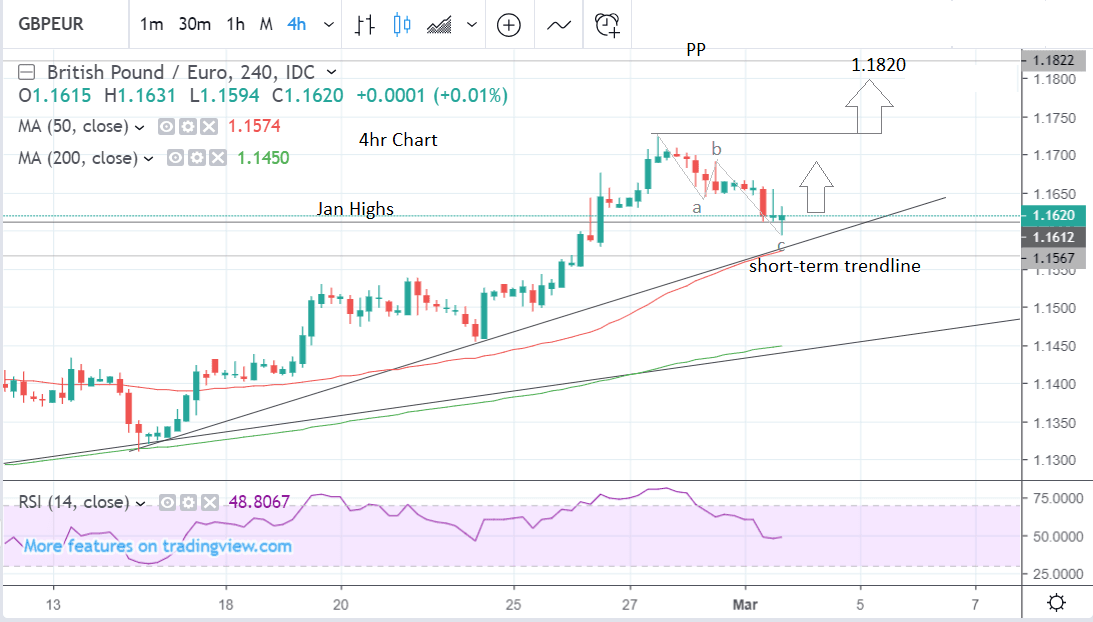The Pound-to-Euro Exchange Rate Week Ahead: Recovery Forecast to Resume

Image © European Central Bank
- Pull-back at end of previous week could be temporary
- Resumption higher in week ahead
- Beware surprise Brexit vote this week
- Euro eyes ECB meeting
Technical conditions continue to favour Pound Sterling over the Euro and we could see gains in GBP/EUR extend after the pullback seen towards the end of the previous week. However, we are wary that Prime Minister Theresa May could bring the second meaningful vote on Brexit to parliament this week.
The Pound-to-Euro exchange rate is trading at 1.1620 at the start of the new week, a full cent higher than at the start of the previous week.
From a technical perspective, GBP/EUR remains in an uptrend, which is forecast to continue. Although it has pulled back from new 2019 highs of 1.1723, achieved last Wednesday, the correction is relatively shallow and more likely to end and result in a recovery, rather than a continuation lower.
The pair has now almost reached a major support level which is likely to prop up the exchange rate, at the 1.1602 January highs, and this is a prime candidate for the scene of a rotation higher.
The pull-back which took place on Thursday and Friday is shallower than the previous rally, which indicates that Monday will probably be an up-day, and is further evidence the uptrend is likely to resume.
The pair formed a rare ‘golden cross’ in February when the 50-day MA crossed over the 200-day and this is too strengthens the bullish case.
Momentum, which was overbought, has now also moved back down out of the overbought zone, indicating traders have lightened their positions a little and the market is now more balanced. This suggests the conditions are now better for a resumption higher since the long trade is less 'crowded'.
The 4hr chart shows the pull-back in more detail and reveals it exhibits a broad three-wave zig-zag patterning which is characteristic of a classic ‘abc’ correction. These are common on charts and usually end in a reversal and resumption of the uptrend, reinforcing the uptrending bias.
The short-term trendline at about 1.1580-90 is another area of support where the pair could reverse and start rising.
Although it looks increasingly likely the exchange rate will start rising up to the 1.1723 highs again quite soon, those seeking more cast iron confirmation of an extension, should wait for the break above the 1.1723 highs first.
Such a break would confirm a continuation of the recovery up to the next target at 1.1820 where the monthly pivot is located. this could happen as soon as the week ahead. At that level, the exchange rate may stall as short-term technical selling and profit-taking disturb the trend, but it will probably eventually continue higher, up to the next major target at 1.2000, our eventual medium-to-long-term goal for the pair, achievable in 1-3 months.
Time to move your money? Get 3-5% more currency than your bank would offer by using the services of foreign exchange specialists at RationalFX. A specialist broker can deliver you an exchange rate closer to the real market rate, thereby saving you substantial quantities of currency. Find out more here. * Advertisement
The Pound: What to Watch this Week
The main releases for the Pound next week are services and construction PMIs for February, although, the possibility of an early meaningful vote on Theresa May’s latest Brexit deal remains an overarching risk.
If Theresa May can win concessions from the EU on making the Irish backstop temporary, she may bring forward the meaningful vote before the March 12 deadline date, which means it could happen as soon as next week.
Due to political manoeuvring, any deal she agrees has a higher chance of getting voted through than was the case in January when the deal was shot down by parliament. Brexiteers fearful of Brexit being reversed could be more prone to back May, provided she can get a legal concession on the backstop.
Last week Sterling rose sharply after the Prime Minister announced a series of votes would take place in the event of her Brexit deal being rejected: one of them would be a vote on requesting a delay to Brexit.
With parliament heavily skewed against a 'no deal' Brexit, markets expect a delay to be requested should May's deal fail: for Brexiteers such an outcome would be incredibly problematic as it could open the door to a series of events that results in a much 'softer' Brexit, or no Brexit at all. Suddenly May's Brexit is looking a whole lot more attractive. Last week we heard Jacob Rees-Mogg, the head of the European Research Group which is a cabal of Brexiteer Conservative Party MPs, was softening his stance on the changes required for the deal to get his backing.
“British Prime Minister Theresa May could bring the meaningful vote on her Brexit deal to Parliament early before the March 12 deadline if she manages to secure the legal assurances she is seeking from the EU that the Irish backstop would be temporary if triggered,” says Raffi Boyadijian, economist at broker XM.com. “There seems to be growing movement within MPs, particularly among Eurosceptics, to back the deal if May obtains the legal guarantee after she offered lawmakers a vote on ruling out a no-deal scenario and extending Article 50. Labour’s backing of a second referendum also rattled hardline Brexiteers who may now fear Brexit could be postponed or even aborted.”
The other main release for the Pound is services and construction PMIs. Construction is the first to be released, on Monday at 9.30 GMT, and is forecast to slow to 50.3 from 50.6 previously.
Services is out on Tuesday at the same time and is forecast to come out at 49.9 from 50.1 in January. The services sector accounts for over 80% of UK economic activity and is therefore the survey markets are most interested in and has the greatest market-moving potential.
PMIs are surveys of pivotal purchasing managers in companies within the target sector. They are a leading indicator for the economy. A lower-than-forecast result could weaken the Pound. The possible dip below 50 for the UK’s key services sector is particularly concerning since 50 is the dividing line between growth and contraction. Brexit is not the only determinant of Sterling. Now that fears of no-deal have eased economic data is playing a greater role too.
The Euro: What to Watch this Week
The main event for the Euro is the European Central Bank (ECB) rate meeting on Thursday at 12.45; whilst no change in policy is expected there is a risk the Bank could announce it is extending its TLTRO programme which provides Eurozone banks with cheap lending, and this would be seen as a de facto form of easing, which could weigh on the Euro.
The ECB was supposed to be hurtling towards an interest rise in 2019, and reopening the TLTRO programme represents a turn away from tighter monetary policy that in turn suggests an interest rate rise has now been kicked forward deep into 2020.
At its previous meeting, the ECB stuck to its roadmap of returning crisis-era monetary policy to normal, which included raising interest rates back up to positive levels after the summer of 2019. If it changes this view, reflected in, perhaps, a change of wording in its statement, this could definitely weigh on the Euro because higher interest rates, or the expectation thereof, is generally positive for a currency, as higher rates attract and keep greater inflows of foreign capital.
At the meeting, the ECB will also release its staff macroeconomic projections and these too will be published with the statement of monetary policy. If they reveal a deeper-than-expected downgrade in forecasts this too could have implications for the Euro which would take any major downgrades negatively. As a comparison, the European Commission's own figures, released at the end of 2018, showed a downward revision of Eurozone growth expectations in 2019 from 1.9% to 1.3%.
On the 'hard' data front, the main release is probably retail sales in January, out on Tuesday at 10.00. This showed a slump of -1.6% in December but markets are expecting a 1.0% recovery in January. Compared to last year, sales are forecast to rise 1.8% from 0.8% previously. If there is no rebound in sales, however, it could pressure the Euro marginally lower.
Other data consists of final revisions - to Q4 GDP and employment change, which unless large, are unlikely to affect the exchange rate.
Time to move your money? Get 3-5% more currency than your bank would offer by using the services of foreign exchange specialists at RationalFX. A specialist broker can deliver you an exchange rate closer to the real market rate, thereby saving you substantial quantities of currency. Find out more here. * Advertisement


